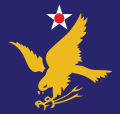| 516th Strategic Fighter Squadron | |
|---|---|
 407th Wing RF-84F Thunderstreaks [a] | |
| Active | 1943–1944; 1953–1957 |
| Country | |
| Branch | |
| Role | Fighter |
| Nickname | Blackfeet |
| Motto | Four Winds |
| Engagements | Aleutian Campaign |
| Insignia | |
| Patch with 516th Strategic Fighter Squadron emblem [b] [1] |  |
The 516th Strategic Fighter Squadron is an inactive United States Air Force unit. Its last assignment was with the 407th Strategic Fighter Wing at Great Falls Air Force Base, Montana, where it was inactivated on 1 July 1957.
Contents
- History
- World War II
- Strategic fighter operations
- Lineage
- Assignments
- Stations
- Aircraft
- Campaigns
- References
- Notes
- Bibliography
The squadron was first activated in March 1943 as the 633d Bombardment Squadron and equipped with light ground attack aircraft. In July 1943, the air echelon of the squadron deployed to the Aleutian Islands to defend against the Japanese attacks there. It returned to the United States the following month and was redesignated the 516th Fighter-Bomber Squadron, while continuing to train for combat with the same mission. It became a Replacement Training Unit, but was disbanded in the spring of 1944 in a general reorganization of Army Air Forces training units.
The squadron was reactivated in 1953 as part of Strategic Air Command (SAC), flying escort fighters and a few air reconnaissance aircraft. In 1954, the squadron deployed to Japan and provided air defense for the northern part of the islands. It supported SAC bombardment operations until inactivating.




